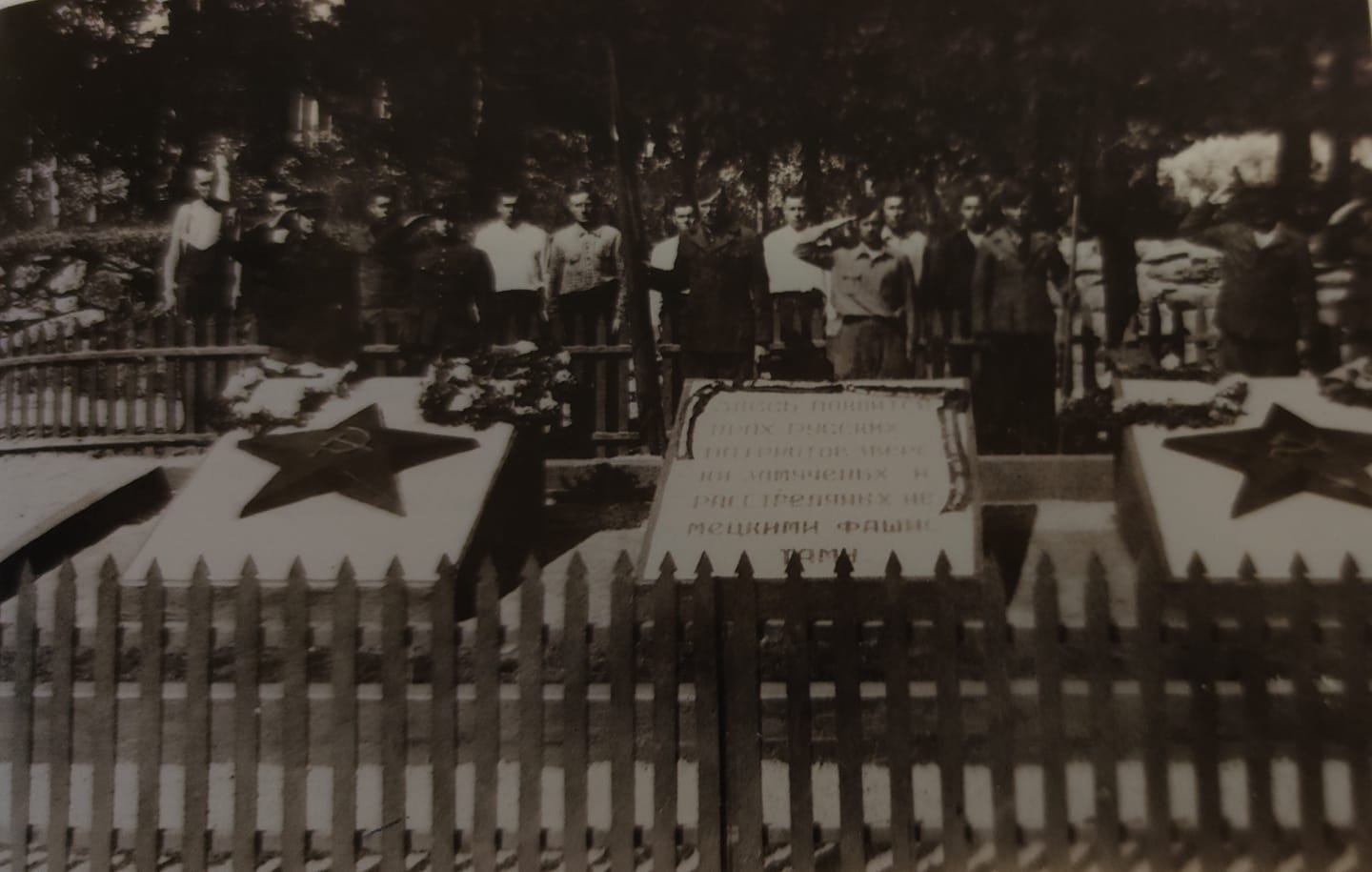Alexander Volyansky was born on November 2, 1920 in the city of Lyubotyn in Ukraine. He was sent to a prison camp in Skeidalen near Bodø in 1944.

Memorial to fallen comrades, erected by prisoners of war
From Oscar Bodøgaard's collection, Bodøgaard art & culture
Alexander Yefimovich Volyansky was then 24 years old. One day while working on the road, hungry as usual, he began to gnaw the bark of a birch trunk. This was not allowed under Nazi regulations. The punishment was ordered by the chief of guards and it was that his teeth should be beaten and pulled out.
Alexander's father was a farmer, but he quit and started as an industrial worker. He died in 1940. Aleksandr had three siblings. In 1940, he finished 10th grade in middle school and began as a student at Leningrad University College for ship engineers.
At the outbreak of war on June 22, 1941, the studies ended and were sent to the front. He received the rank of lieutenant and ended up in the town of Kandalaksja in the heart of Lake Kvitsjøen. They were to fight against the Karelian front in Finland. He mastered skiing since he had skied a lot while growing up at home in Ukraine.
They were beaten in a battle with the Germans and captured. When the Germans withdrew from Finland and the prisoners of war were sent to Norway. Alexander was sent out on a long and hard march. Prisoners who were unable to follow the march towards Norway were shot in the road ditch.
In the autumn of 1944 he came to a camp near Fauske in Nordland, Norway. Here he was so lucky that he went to work as an assistant to a Czech chef who cooked for the Germans. He had this job for about 1.5 months until he was caught giving "replacement chops" to his fellow prisoners. As punishment, he was sent to a penal camp in Bodø. That camp was in Skeidalen by Bodin church. The Germans called the camp "Bodø-Scharfelager". It was a camp with a dozen cabins of the worst kind.
In the camp he had to build a road about 5 kilometers from the camp. They marched to the workplace every morning and back to camp every afternoon. There was little food and they starved. It was now that he was caught gnawing bark and the punishment was as mentioned that his teeth should be knocked out. Part of his teeth was knocked out and some teeth were extracted with a tooth. Afterwards it hurt violently in the tooth stumps with pain and inflammation. His mouth was swollen and he had trouble swallowing food.
One day in March 1945, he escaped and hid in the forest. He was found by some Norwegians who took him with him, gave him clothes, shoes and food. Those who found him belonged to a resistance group of about 20 people who carried out actions against the Germans. The leader called himself Eriksen and spoke a little German. After a month, Aleksandr was in such shape that he could take part in actions against the Germans.
When peace came on May 8, 1945, Aleksandr returned to the camp in Skeidalen and to his fellow prisoners. At that time there were 144 prisoners in the camp and of these only 15 were able to work. Alexander Voljansky and the other able-bodied people built a memorial at Bodin Church over their dead comrades. For this, they received help from some Norwegians, including Oscar Bodøgaard (after each a well-known artist) who used horses and carriages and drove sand from the yeast at Lake Bodø. The memorial was completed on July 26, 1945. At that time, all 16 were photographed at the beautiful memorial. The photograph was well taken care of by Aleksandr Voljansky in the years that followed.
When he returned home, he was put in serious interrogation, but after a month he was allowed to go home to Ljubotyn. Here he was received by his mother and siblings. Here he worked until he retired in 1980.
Aleksandr saved money all those years to visit Bodø again and the memorial they built. And in 1990 he came for the first time and was then 70 years old. Unfortunately, the memorial was destroyed by the Norwegian authorities as part of Operation "Asphalt" in the early 1950s.
Unfortunately, there is no memorial today for the victims and the efforts that the Ukrainians made in Norway during 1940-1945. It is a shame for the nation of Norway.
During the first autumn, the Germans took one enormous number of prisoners of war, in total during the war this increased to nearly six million. Of these perished around 3,400,000.
Initially, there were no plans from Hitler to use Soviet prisoners of war labor in the German Empire, but the war economy and the large-scale construction projects that were put in place
time, including in Norway, made the Germans dependent on it. In total, Nazi Germany took advantage of more than 13 million prisoners of war in the war effort.
From 1941 to 1945, around 100,000 Soviet prisoners of war came to Norway. The vast majority of were soldiers from the Red Army, but there were also civilian forced laborers - "Cheese workers" - and volunteer refugees, who had accompanied the German army to avoid being sent back to Stalin.
In Norway, the prisoners of war were scattered over almost 500 prison camps, and the majority were sent to the three northernmost counties where the Germans started large construction projects such as the Nordlandsbanen, Riksvei 50 [E6], several airports and fortresses along the coast. Some of the civilian forced laborers were also ordered to work at aluminum factories and frozen fillet factories. In addition to Soviets, there were also Yugoslav and Polish prisoners of war in Norway, and over 15,000 civilian workers from a number of other countries in Europe.

Comments powered by CComment